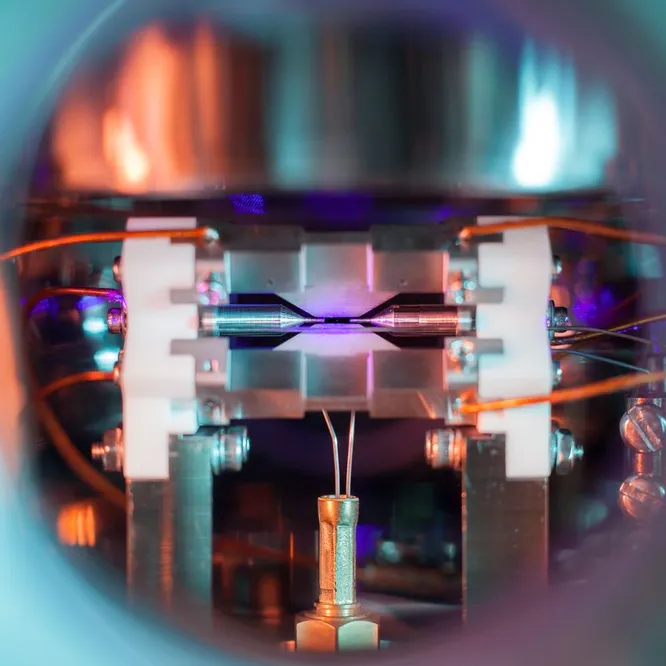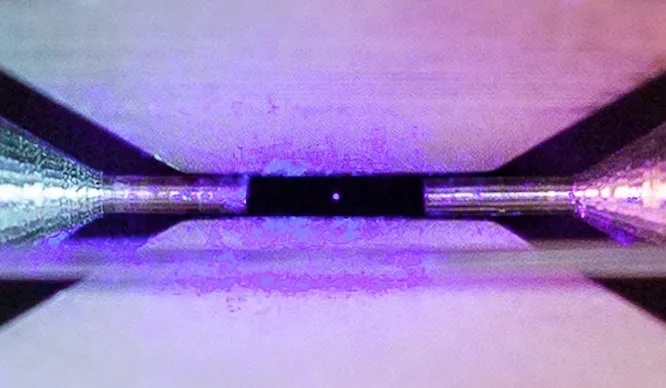Atoms are very small, they are so small that a person cannot see them, even with the help of powerful microscopes. But, paradoxically, on this photo of an atom (and not just a picture) you can see the chat with the naked eye. Today we will tell you about how a real photo of an atom was taken.
This is a real photo of an atom under an electron microscope made by David Nadlinger and it is called “A single atom in an ion trap”. A couple of years ago, she won the competition for the best scientific photography conducted by the Research Council of Engineering and Physical Sciences of Great Britain. The photo shows a single strontium atom in a powerful electric field. Lasers are aimed at it, which is why the atom emits light.
What we see in the picture
Even if the particle is visible, it’s still not easy to see how the atom looks in the photo. If you look closely at the center of the photo, you will notice a faintly glowing blue dot. This is the strontium atom illuminated by a blue-violet laser.

It is noteworthy that the atom was photographed with an ordinary digital camera. In addition to it, flashes with light filters and extension rings for macro photography were used. When illuminated by a laser, the strontium atom absorbed and then re-emitted photons of light. The reflected light was captured by the camera at a long shutter speed. Atoms without a microscope can only be seen in the photo. The title of the photo is “A single atom in an ion trap”. What kind of trap is this? Its electric fields are generated by metal electrodes. In the photo of the strontium atom in the microscope, the fields were two millimeters.
Strontium was used in the experiment because of its size: strontium has 38 protons, and the diameter of its atom is several millionths of a millimeter. Normally, we wouldn’t have seen such a small object, but scientists used a trick to make the atom brighter. Thanks to this, a beautiful photo of the atom turned out.
How the picture was taken
In the photo, an atom under an electron microscope is illuminated by a high-power laser, due to which the electrons orbiting around the strontium atom receive more energy and begin to emit light. As soon as the charged electrons gave enough light, the most ordinary camera was able to take a real photo of the atom.
However, if you personally stood next to this installation, you would not see anything. The picture was taken with the help of a long shutter speed, because without equipment, all this light would still not be noticed. Unfortunately, there is simply no other way for a person to see a real single atom with the naked eye. Not yet. We hope that soon the scientific world will once again delight us with new photos of atoms.

The author of the photo, David Nadlinger, took a photo of an atom in a microscope through the window of an ultra-high vacuum chamber, in which an ion trap is enclosed. This technique is not new, but Nadlinger did it for the first time with a conventional camera. He managed to capture what an atom looks like under a microscope in a photo using a Canon 5D Mk II camera.
Why is the picture interesting for science
Currently, ion traps are ubiquitous. Many of them are based on the interaction of charged particles with a high-frequency electromagnetic field. A British scientist used a quadrupole ion trap for his photo of an atom under a microscope, the second name of which is the Paul trap. Ion traps are widely used for mass spectrometry, a method of studying a substance in which the concentration of components in it is determined – molecular weight, composition and formula. Ion traps are used, among other things, in chemical industries for air filtration.
